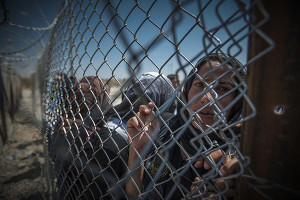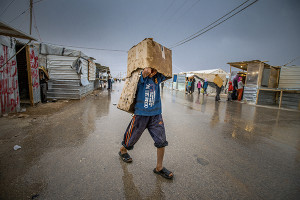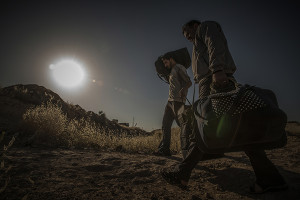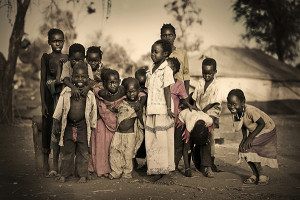.
According to the newly released UN Refugee Agency (UNHCR) Global Trends Report, 59.9 million individuals were forcibly displaced in 2014. This number represents a 40 percent increase over three years, revealing the rapid growth rate of displacement.
A World of Refugees
Of the 59.9 million forcibly displaced persons, 14.9 million were considered refugees or in refugee-like situations at the end of 2014, marking a 23 percent increase in the global number of refugees under UNHCR’s mandate. This number reflects the largest number of refugees globally since 1995.
Notably, children younger than 18 years of age constitute 51 percent of the refugee population, which is 41 percent more than in 2009. The prevalence of refugee children is largely the result of the crisis in Syrian Arab Republic, coupled with Afghanistan’s immense number of refugees who have been in exile for five or more years.
For the first year ever, Turkey surpassed Pakistan to become the top host-country for refugees, with 1.59 million refugees entering the country. This is largely due to Turkey’s close proximity to the Syria, which is entering its fourth year of war. The conflict in Syria has left 3.88 million persons forcibly displaced, with many seeking refuge in neighboring states. .
The top ten refugee-hosting countries collectively host 57 percent off all refugees, highlighting a heavy concentration of refugees in three regions: East and Horn of Africa, Asia and Pacific, and Middle East and North Africa. These areas of high concentration are primarily the result of refugees fleeing to states that neighbor their country of origin. For example, 95 percent of Syrian refugees sought shelter in nearby nations, like Turkey and Lebanon. Turkey, Pakistan, and Lebanon make up the top three host countries of refugees.
In 2014, Syria became the top country of origin for refugees, a position previously filled by Afghanistan, which held the slot for 30 years. Notably, Syria was not even listed in the top 30 source countries until three years ago.
The Search for Stability
126,800 refugees returned home in 2014, which is the lowest number of returning refugees recorded since 1983. In 2013, 414,600 refugees returned home, marking a significant decrease in refugee-returns within a single year. The past decade similarly witnessed lower refugee returns (5.2 million) than the preceding decade (13.0 million). Recently, low refugee return rates are heavily due to increased global political insecurity and wars.
UNHCR advocates three types of solutions: voluntary repatriation, resettlement, and local integration. Of these, voluntary repatriation ranks highest numerically. In addition to the UNHCR’s work to help new and existing refugees, the organization and its partners also work to address the concerns of special groups, like former refugees.
Trapped within Borders
UNHCR registered and extended aid to 32.3 million internally displaced persons (IDPs), including those in IDP-like situations, during 2014. This is 8.3 million more people than in 2013 and the highest figure on record. Syria, Iraq, the Democratic Republic of the Congo, Ukraine, South Sudan, and Pakistan heavily contributed to this figure. According to the report, Syria hosted 7.6 million IDPs, making the state the country with the highest IDP population worldwide.
Looking for Refuge
2014 experienced the highest number of applications for asylum or refugee status ever recorded. 1.66 million applications were submitted to States or UNHCR in 157 countries or territories during the past year. The number of applications submitted last year marks a 54 percent increase since 2013, when 1.08 million asylum claims were submitted. Of the 1.66 million claims submitted in 2014, 1.47 million were initial applications, highlighting recent outbreaks of violence.
The Russian Federation hosted 274,700 registered individual asylum requests, making it the largest recipient of new individual asylum claims in 2014. Contrastingly, South Africa, which was the top destination country of new asylum-seekers between 2008 and 2012, saw drops in applications in both 2013 and 2014.
Without a State
In 2014, UNHCR initiated the Global Action Plan to End Statelessness: 2014-2024. The plan aims to end statelessness within a decade and focus on accumulating better data on the phenomenon of statelessness so that the organization can better address the issue. In 2014, data on statelessness was released by 77 countries, marking a two-country increase from 2013. However, the data collected for 2014 reports almost 3.5 million stateless persons, but the estimated stateless population is actually around 10 million. This highlights an existing gap between collected data and estimations that the UNHCR hopes to close.
[caption id="attachment_5899" align="alignnone" width="300"] Syrian refugee families arrive at the UNHCR Zatari refugee camp and await registration at the main entrance centre.[/caption]
[caption id="attachment_5900" align="alignnone" width="300"]
Syrian refugee families arrive at the UNHCR Zatari refugee camp and await registration at the main entrance centre.[/caption]
[caption id="attachment_5900" align="alignnone" width="300"] A young Syrian refugee shelters from the rain with a cardboard box. Extreme weather - from sandstorms to thunderstorms - are a common occurence in UNHCR Zaatari refugee camp and make life difficult for the people living there.[/caption]
A young Syrian refugee shelters from the rain with a cardboard box. Extreme weather - from sandstorms to thunderstorms - are a common occurence in UNHCR Zaatari refugee camp and make life difficult for the people living there.[/caption]
 [caption id="attachment_5902" align="alignnone" width="300"]
[caption id="attachment_5902" align="alignnone" width="300"] Children play in a safe play area of the UNHCR refugee camp Doro in Mabaan County, South Sudan. The children can play in complete safety without fear or hindrance.[/caption]
Children play in a safe play area of the UNHCR refugee camp Doro in Mabaan County, South Sudan. The children can play in complete safety without fear or hindrance.[/caption]
 Syrian refugee families arrive at the UNHCR Zatari refugee camp and await registration at the main entrance centre.[/caption]
[caption id="attachment_5900" align="alignnone" width="300"]
Syrian refugee families arrive at the UNHCR Zatari refugee camp and await registration at the main entrance centre.[/caption]
[caption id="attachment_5900" align="alignnone" width="300"] A young Syrian refugee shelters from the rain with a cardboard box. Extreme weather - from sandstorms to thunderstorms - are a common occurence in UNHCR Zaatari refugee camp and make life difficult for the people living there.[/caption]
A young Syrian refugee shelters from the rain with a cardboard box. Extreme weather - from sandstorms to thunderstorms - are a common occurence in UNHCR Zaatari refugee camp and make life difficult for the people living there.[/caption]
 [caption id="attachment_5902" align="alignnone" width="300"]
[caption id="attachment_5902" align="alignnone" width="300"] Children play in a safe play area of the UNHCR refugee camp Doro in Mabaan County, South Sudan. The children can play in complete safety without fear or hindrance.[/caption]
Children play in a safe play area of the UNHCR refugee camp Doro in Mabaan County, South Sudan. The children can play in complete safety without fear or hindrance.[/caption]The views presented in this article are the author’s own and do not necessarily represent the views of any other organization.


a global affairs media network
New Report Reveals Refugee Rates are at Their Highest Since 1995

A young Syrian refugee shelters from the rain with a cardboard box. Extreme weather - from sandstorms to thunderstorms - are a common occurence in UNHCR Zaatari refugee camp and make life difficult for the people living there.|Syrian refugee families arrive at the UNHCR Zatari refugee camp and await registration at the main entrance centre.||Children play in a safe play area of the UNHCR refugee camp Doro in Mabaan County, South Sudan. The children can play in complete safety without fear or hindrance.
June 22, 2015
According to the newly released UN Refugee Agency (UNHCR) Global Trends Report, 59.9 million individuals were forcibly displaced in 2014. This number represents a 40 percent increase over three years, revealing the rapid growth rate of displacement.
A World of Refugees
Of the 59.9 million forcibly displaced persons, 14.9 million were considered refugees or in refugee-like situations at the end of 2014, marking a 23 percent increase in the global number of refugees under UNHCR’s mandate. This number reflects the largest number of refugees globally since 1995.
Notably, children younger than 18 years of age constitute 51 percent of the refugee population, which is 41 percent more than in 2009. The prevalence of refugee children is largely the result of the crisis in Syrian Arab Republic, coupled with Afghanistan’s immense number of refugees who have been in exile for five or more years.
For the first year ever, Turkey surpassed Pakistan to become the top host-country for refugees, with 1.59 million refugees entering the country. This is largely due to Turkey’s close proximity to the Syria, which is entering its fourth year of war. The conflict in Syria has left 3.88 million persons forcibly displaced, with many seeking refuge in neighboring states. .
The top ten refugee-hosting countries collectively host 57 percent off all refugees, highlighting a heavy concentration of refugees in three regions: East and Horn of Africa, Asia and Pacific, and Middle East and North Africa. These areas of high concentration are primarily the result of refugees fleeing to states that neighbor their country of origin. For example, 95 percent of Syrian refugees sought shelter in nearby nations, like Turkey and Lebanon. Turkey, Pakistan, and Lebanon make up the top three host countries of refugees.
In 2014, Syria became the top country of origin for refugees, a position previously filled by Afghanistan, which held the slot for 30 years. Notably, Syria was not even listed in the top 30 source countries until three years ago.
The Search for Stability
126,800 refugees returned home in 2014, which is the lowest number of returning refugees recorded since 1983. In 2013, 414,600 refugees returned home, marking a significant decrease in refugee-returns within a single year. The past decade similarly witnessed lower refugee returns (5.2 million) than the preceding decade (13.0 million). Recently, low refugee return rates are heavily due to increased global political insecurity and wars.
UNHCR advocates three types of solutions: voluntary repatriation, resettlement, and local integration. Of these, voluntary repatriation ranks highest numerically. In addition to the UNHCR’s work to help new and existing refugees, the organization and its partners also work to address the concerns of special groups, like former refugees.
Trapped within Borders
UNHCR registered and extended aid to 32.3 million internally displaced persons (IDPs), including those in IDP-like situations, during 2014. This is 8.3 million more people than in 2013 and the highest figure on record. Syria, Iraq, the Democratic Republic of the Congo, Ukraine, South Sudan, and Pakistan heavily contributed to this figure. According to the report, Syria hosted 7.6 million IDPs, making the state the country with the highest IDP population worldwide.
Looking for Refuge
2014 experienced the highest number of applications for asylum or refugee status ever recorded. 1.66 million applications were submitted to States or UNHCR in 157 countries or territories during the past year. The number of applications submitted last year marks a 54 percent increase since 2013, when 1.08 million asylum claims were submitted. Of the 1.66 million claims submitted in 2014, 1.47 million were initial applications, highlighting recent outbreaks of violence.
The Russian Federation hosted 274,700 registered individual asylum requests, making it the largest recipient of new individual asylum claims in 2014. Contrastingly, South Africa, which was the top destination country of new asylum-seekers between 2008 and 2012, saw drops in applications in both 2013 and 2014.
Without a State
In 2014, UNHCR initiated the Global Action Plan to End Statelessness: 2014-2024. The plan aims to end statelessness within a decade and focus on accumulating better data on the phenomenon of statelessness so that the organization can better address the issue. In 2014, data on statelessness was released by 77 countries, marking a two-country increase from 2013. However, the data collected for 2014 reports almost 3.5 million stateless persons, but the estimated stateless population is actually around 10 million. This highlights an existing gap between collected data and estimations that the UNHCR hopes to close.
[caption id="attachment_5899" align="alignnone" width="300"] Syrian refugee families arrive at the UNHCR Zatari refugee camp and await registration at the main entrance centre.[/caption]
[caption id="attachment_5900" align="alignnone" width="300"]
Syrian refugee families arrive at the UNHCR Zatari refugee camp and await registration at the main entrance centre.[/caption]
[caption id="attachment_5900" align="alignnone" width="300"] A young Syrian refugee shelters from the rain with a cardboard box. Extreme weather - from sandstorms to thunderstorms - are a common occurence in UNHCR Zaatari refugee camp and make life difficult for the people living there.[/caption]
A young Syrian refugee shelters from the rain with a cardboard box. Extreme weather - from sandstorms to thunderstorms - are a common occurence in UNHCR Zaatari refugee camp and make life difficult for the people living there.[/caption]
 [caption id="attachment_5902" align="alignnone" width="300"]
[caption id="attachment_5902" align="alignnone" width="300"] Children play in a safe play area of the UNHCR refugee camp Doro in Mabaan County, South Sudan. The children can play in complete safety without fear or hindrance.[/caption]
Children play in a safe play area of the UNHCR refugee camp Doro in Mabaan County, South Sudan. The children can play in complete safety without fear or hindrance.[/caption]
 Syrian refugee families arrive at the UNHCR Zatari refugee camp and await registration at the main entrance centre.[/caption]
[caption id="attachment_5900" align="alignnone" width="300"]
Syrian refugee families arrive at the UNHCR Zatari refugee camp and await registration at the main entrance centre.[/caption]
[caption id="attachment_5900" align="alignnone" width="300"] A young Syrian refugee shelters from the rain with a cardboard box. Extreme weather - from sandstorms to thunderstorms - are a common occurence in UNHCR Zaatari refugee camp and make life difficult for the people living there.[/caption]
A young Syrian refugee shelters from the rain with a cardboard box. Extreme weather - from sandstorms to thunderstorms - are a common occurence in UNHCR Zaatari refugee camp and make life difficult for the people living there.[/caption]
 [caption id="attachment_5902" align="alignnone" width="300"]
[caption id="attachment_5902" align="alignnone" width="300"] Children play in a safe play area of the UNHCR refugee camp Doro in Mabaan County, South Sudan. The children can play in complete safety without fear or hindrance.[/caption]
Children play in a safe play area of the UNHCR refugee camp Doro in Mabaan County, South Sudan. The children can play in complete safety without fear or hindrance.[/caption]The views presented in this article are the author’s own and do not necessarily represent the views of any other organization.


